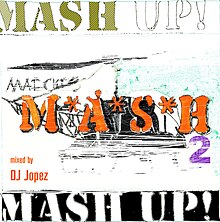Mashup (culture)
| Mashup Culture | |
|---|---|

Cover of the Mixtape Mash Up 2 by DJ Jopez
|
|
| Stylistic origins | Pop, rock, electronic |
| Cultural origins | Late 1990s, 2000s; Europe, North America |
| Typical instruments | Digital audio editor, sampler, sequencer, DJ turntables, audio mixer |
| Derivative forms | Sampling, sound collage, remix |
| Subgenres | |
| Glitch pop | |
| Regional scenes | |
| United Kingdom, United States, Germany, France, Australia, Norway, Netherlands, Switzerland, Sweden, Indonesia, Canada, India, Belgium, Austria, Brazil, Italy, Japan | |
Participants in an online music scene who rearrange spliced parts of musical pieces form Mashup Culture. The audio-files are normally in MP3 format and spliced with audio-editing software online. The new, edited song is called mashup. The expression mashup culture is also strongly connected to mashup in music. Even though it is originally not a political community, the producer of mash-up music are related to the issue of copyright. Mashup Culture is even regarded as “a response to larger technological, institutional, and social contexts".
The history of mashup culture in general can be dated back to the beginnings of dada and conceptual art. Artists such as Marcel Duchamp were the first to introduce already existing objects, which they rearranged and combined in collages, to the world of higher art. These artists believed that even though certain artifacts were ascribed a certain meaning, this meaning could be altered through rearranging them and putting them into a new context. However, it was still quite a long way to the beginning of mashup culture in music. From the early 2000s on, music was more and more distributed through the internet. With the introduction of MP3 audio files, it became much easier to access and download music. Not only could music be accessed easier, it could also be transformed and mixed in ways that were not possible before. Especially for younger people, this new gained freedom when it came to the accessibility of audio files lead to the development of a new form of cult around the transformation of musical pieces. This "reworking MP3 recordings pulled from the Internet" was turning into more than just a fashion just as "the Internet is more than just a means of distribution, it becomes a raison d’eˆtre for a culture based on audio data’’ states Alistair Riddell in 2001. During that time, the first versions of mashup music were published, sometimes not under the term mashup but under the name of "creative bootleg" or "bastard pop". Even though the creation of a new song by combining at least two samples of different songs was also used in other music styles such as Hip Hop before, it was only with the rise of the MP3 audio file along with easy-to-use computer mash-up programs that mash-up was transformed into an own culture as such. Especially peer-to-peer sharing was contributing to this phenomenon: People who create mashup music can easily distribute it and share it with other people through online programs.
...
Wikipedia
